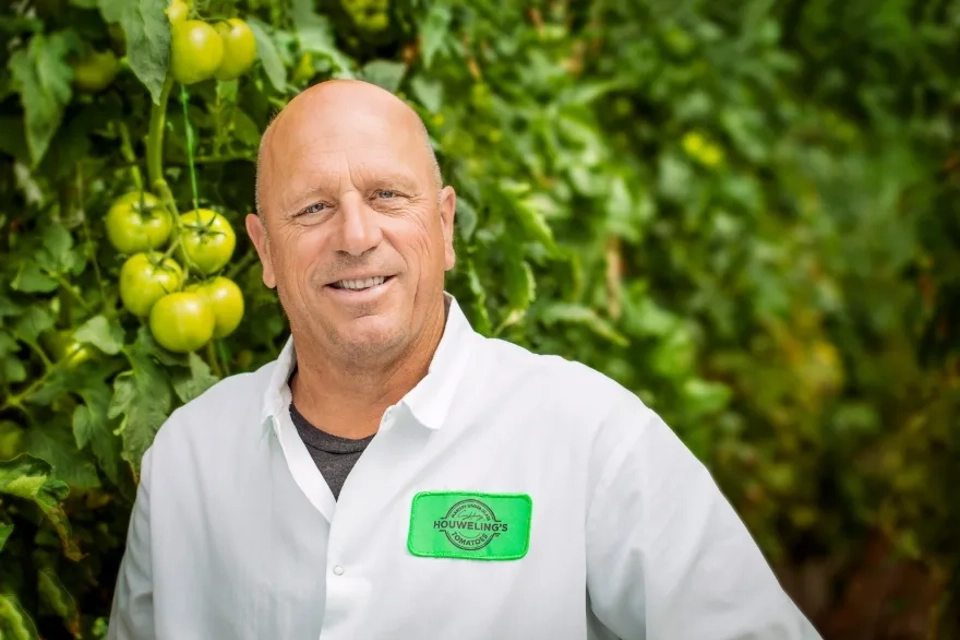KUBO Group bestaat uit vier bedrijven die elkaar versterken en ondersteunen. Bij KUBO Group en haar dochterondernemingen staan we synoniem voor innovatie en duurzaamheid, en streven we voortdurend naar vooruitgang in de agrarische sector.
Casey Houweling, de 'founding father' van de Ultra-Clima® kas: 'KUBO geloofde in het idee'.
Zou de Ultra-Clima kas er óók zijn gekomen als een tomatenteler in Californië geen last had gehad van witte vlieg? Vermoedelijk wel. Al heeft het wel geholpen dat die teler niet de eerste de beste was: Casey Houweling. De verantwoordelijke kassenbouwer trouwens ook niet. Samen met KUBO stond de Amerikaanse teler met ‘Dutch roots’ aan de basis van de grootste innovatie in de kassenbouw. ‘Wordt het vandaag 34 graden met een luchtvochtigheid van 5%? Daar kunnen we makkelijk mee dealen.’
‘We hadden heel veel last van witte vlieg’, begint Casey zijn verhaal. ‘Die brachten ook een virus mee, het ToCV-virus. Ik ben naar Spanje gegaan om te kijken wat ze daar tegen een probleem als dit deden. Die telers gebruikten insectenschermen. We hebben er meteen 20.000 besteld. De leverancier had zoveel capaciteit niet en heeft de productie uitbesteed aan een Italiaanse fabrikant. Zes maanden later vielen al die schermen naar beneden, omdat ze niet UV-proof waren!’
Het is achteraf het moment waarop de evolutie van de Ultra-Clima kas begint, zegt Casey. Hij is oud-eigenaar van Houwelings Tomatoes dat in Californië en Canada op 90 hectare tomaten teelt, waarvan eenderde Ultra-Clima. ‘Die insectenschermen kostten koelcapaciteit, je had lichtverlies en je kreeg een shitty klimaat.’ Om toch insecten buiten te houden ontstaat het idee om overdruk in de kas te creëren. ‘We zijn op kleine schaal in een deel van de kas gaan experimenteren met slangen en een koeling pad. KUBO heeft samen met Enerdes, een Nederlandse leverancier van kasklimaatsystemen, een concept ontwikkeld. Al na anderhalf jaar hebben we bij KUBO de eerste Ultra-Clima kas van 16 hectare. Ja, 16 hectare. We hadden het idee dat we wel genoeg geleerd hadden.’
Modificaties
Het concept van de revolutionaire kas blijkt te werken, al komen er modificaties aan te pas. Casey: ‘We zijn begonnen met één slang in de kas. Bij het begin van de fan heb je een airflow van 100%. Maar aan het eind van de slang daalde die airflow naar nul, doordat de slang een hoek van 90 graden maakt. Dus kreeg je temperatuurverschillen in het gewas. Met een rookmachine hebben we getest hoe de lucht zich verplaatste door de kas.’ De oplossing is simpel: een tweede slang erbij, over een afstand van 125 meter. ‘Dat was vijftien jaar geleden het eigenlijke begin van het succes. Nu zie je de Ultra-Clima kas over heel de wereld. We hebben het concept meteen laten patenteren. Maar we hebben wel geleerd: een patent laat zich moeilijk beschermen. Copycats zijn er altijd.’
Twijfels over elders in de wereld
Al was een wereldwijd succes niet ingecalculeerd, toen de kas in het Californische klimaat zijn waarde had bewezen. ‘Aan het begin had ik twijfels of het wel elders in de wereld zou kunnen werken. Maar hoe meer ik begon te leren, hoe meer ik erin ging geloven. Je hebt een enorme spreiding in mogelijkheden. Ook in woestijnen of extreem droge klimaten kun je nu veel goedkoper groenten telen. Je kunt telen in gebieden waar het moeilijk is om aan water te komen.’
Andere manier van telen
De nieuwe kas brengt ook een andere manier van telen met zich mee. Wanneer hadden hij en zijn teeltmedewerkers die methode in de vingers? ‘Je moet leren van alle opties die een Ultra-Clima kas met zich meebrengt. Je moet een andere groeistijl introduceren. Ik gebruik weleens het voorbeeld van een auto. Voor een automobilist is het eenvoudig om de topsnelheid van een Volkswagen te halen. Maar in een Maserati moet je een héél goede rijder zijn. Ik denk dat het proces om het in de vingers te krijgen toch gauw vijf jaar heeft geduurd. Ook met alle veranderingen doorvoeren in de klimaatcomputer. En nu zegt een teler: oh, wordt het vandaag 34 graden met een luchtvochtigheid van 5%? Daar kunnen we makkelijk mee dealen. Het enige wat nog moeilijk is, is een hoge luchtvochtigheid in een tropisch klimaat.’
Game changer
De Ultra-Clima kas is een echte game changer, constateert hij als ‘founding father’. ‘In een kas op overdruk blijft het kasdek schoner, je hebt 95% minder luchtramen nodig, de kas kan met minder CO2 toe.’ Wel zijn in de loop van de jaren veranderingen aangebracht. ‘Het gaat niet om heel grote veranderingen, het is nog steeds dezelfde kas. KUBO heeft de productiewijze aangepast om efficiënter te kunnen produceren, de energie-efficiëncy is verhoogd en de CO2-uitstoot verlaagd. Maar we zijn er nog lang niet. Er is veel meer mogelijk dan alleen maar het klimaat. Ik denk aan innovaties op het gebied van autonoom telen, van onderhoud, van arbeidsmanagement. Er komen robots. Mensen willen steeds minder lang werken.’
Vriendschappelijke relatie met KUBO
Zou de Ultra-Clima kas ooit het licht hebben gezien als Casey niet KUBO in de arm had genomen? Casey schudt het hoofd. ‘Vanaf dag één geloofde KUBO in het idee. Ze supportten ons, ze hebben het concept samen met ons ontwikkeld. Van een working relationship is het uiteindelijk uitgegroeid tot een vriendschappelijke relatie. En we hebben al tientallen jaren een relatie met KUBO hè. Ik heb Wouters opa nog gekend. Dat maakte het eenvoudiger om samen deze stap te zetten. Voor Houweling Tomatoes is KUBO een strategische partner. Je moet vertrouwen in elkaar kunnen hebben.’
Vertrouwen dat zelfs nog verder gaat dan alleen maar de bouw van eigen kassen. ‘Waar ik nog heel erg trots op ben is het project Seeds of Tomorrow, een vermeerderingskas die we samen hebben laten bouwen in Guatemala in een gebied met veel armoede.’



